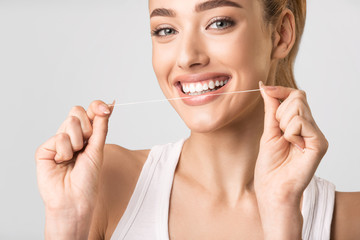Latest Update
 09 Mar 2021
09 Mar 2021 8 Dental Myths Demystified
8 Dental Myths Demystified
Myth 1 – White teeth are healthier than yellow teeth
Everyone wants a white and bright smile. It is aesthetically pleasing to have whiter teeth however whiter teeth are not necessarily healthier than yellow teeth. If teeth do not have decay and gums are healthy then despite the colour, your teeth are still healthy. Teeth colour is similar to skin colour, it is hereditary and doesn’t have anything to do with the health of your teeth.
In saying that, this only applies for natural tooth colour. If your teeth are yellow or stained due to calculus and plaque build-up, it is not considered healthy and you should consider visiting the dentist before this build-up causes any decay or gum problems.
Myth 2 – Bleaching teeth is dangerous
Yellow and healthy teeth do not need to be whitened if you are happy with the colour. If you desire to have whiter teeth to enhance your smile, there is nothing to worry about as whitening or bleaching can be easily done. Contradicting general belief, whitening is a safe procedure. Teeth bleaching is not only a less costly alternative to veneers; it is a conservative and non-invasive technique which is safe and effective. Bleaching gel produces free oxygen radical to lighten teeth without changing the tooth structure.
Myth 3 – Flossing is not important
It is absolutely not correct that flossing is not important. All teeth have five surfaces and two of those surfaces are in contact with adjacent teeth. Toothbrushes cannot clean in-between the two teeth. Floss can slide between these two teeth and clean these surfaces. Insufficient cleaning of these surfaces will lead to tooth decay and gum problems. It is important to floss at least once a day to maintain optimum oral health.
Myth 4 – Veneers require aggressive preparation
Veneers are a common procedure nowadays to improve your smile and confidence. Many times people want veneers to improve smile but are under impression that it will be quite damaging to your teeth. With material and procedural improvements, veneers only need minimal prep of 0.3 to 0.5 mm and sometimes no prep. In some instances where major corrections are needed, teeth can be aligned better before doing veneers to conserve tooth structure. Don’t deprive yourself of a confident smile!
Myth 5 – The harder and more often you brush, the healthier your teeth will be!
Toothbrushes are the easiest way to remove plaque, when you brush your teeth twice a day you keep your plaque levels to a minimum while reducing the about of abrasive forces applied to your teeth. When you brush more often you are not necessarily removing more plaque while increasing the risk of abrasion to your teeth. These abrasions can wear down your enamel and reduces the protection your tooth has against decay and sensitivity. Brushing twice a day with a soft toothbrush for two minutes and flossing once a day is the perfect way to maintain your oral health.
Myth 6 – Dental treatment should be avoided during pregnancy
There is an exaggerated response to plaque in pregnancy due to hormonal changes, which causes excessive bleeding and inflammation from gums in pregnancy. Plaque can cause decay, if left untreated decay can get worse and cause serious problems. It is better to maintain regular hygiene appointments to avoid any surgical treatment in third trimester. If regular appointments are not maintained this increases the risk to the baby and the parent.
Myth 7 – Dental x-rays are unnecessary
X-rays are very important for many different reasons; we recommend x-rays every two years to check your mouth is healthy and free of issues such as gum disease, tooth decay and bone loss. They play a vital role in check-ups, allowing us to catch potential problems earlier, before they become painful and expensive. They also can be used to diagnose tumours and cysts in the mouth or jaw. X-rays are also a good way for you to see for yourself the visible, existing physical conditions.
Myth 8 – Scaling is not good for teeth
Scaling is very important for teeth and gum health, if not done regularly it can cause chronic periodontal disease. Plaque build-up has been linked to an increased risk of cardiovascular conditions. You may be more susceptible to gum disease if you have other systemic diseases like diabetes, cardiovascular disease or rheumatoid Arthritis. Plaque builds up on your teeth and gums, although you may be brushing and flossing it is very hard to clean in all the little nooks and crannies. Although this regular clean is needed every day, twice a day; it is good to have a big ‘spring clean’ every six months where we scale and polish your teeth while looking for any new decay.
 13 Oct 2020
13 Oct 2020 Top 10 Tips on Having Healthy Teeth
10 Tips to Keep Teeth Healthy
The only way to have a great smile is with proper oral hygiene and good dietary habits. Here are some tips to help you keep or get that beautiful, bright smile.
Learn to Brush the Right Way
It should normally take two minutes to brush each time. You should be holding the brush at a 45 degree angle while brushing lightly against your teeth and gums. Pressing down too hard could damage the outer shell of the teeth, also known as enamel. Use a soft toothbrush and brush twice a day especially after meals. Don’t neglect the back teeth and tongue.
Floss
It is recommended that you floss once a day. Food and plaque can be found between our teeth in those hard to reach spaces that our toothbrush just can’t quite get to. Flossing prevents that leftover food from staying embedded between the teeth and hardening into tartar or calculus. It doesn’t matter whether you floss before or after your meal, just do it.
Limit Sugar in Food
Be careful of the sugars that are hidden in foods. Try to switch out sugary foods and drinks for fruits and water. It’s no secret that sugar is the cause for cavities. According to Colgate.com, each time you consume food and drinks that contain sugars or starches, the bacteria in plaque produce acids that attack your teeth for twenty minutes or more. That’s more of a reason to ease up on the sugar if you ask me.
Avoid Staining Your Teeth
Want pearly whites? Avoid any dark food or drink items which are prone to stain and darken your teeth. Excessive intake of dark food and drink items such as wines, coffee and tea can cause staining of teeth. Red wines produce tooth-discoloring pigments. Red and white wines both contain acid, which can erode enamel and can cause stains from other foods or drinks to penetrate more deeply. Another thing is there is dryness of the mouth due to tannins present in red wine. Smoking is the other main culprit.
Replace Your Toothbrush
Change your toothbrush every three months. Old bristles could be hard and can cause damage to teeth and gums.
Prevent Teeth Injuries
Ever use your teeth to open that stubborn package? Well stop! You are at risk of chipping or breaking your teeth. No more opening bottles, chewing ice or anything of that nature. Your teeth should be just for chewing food. Avoid hard or frozen lollies or foods. Also, when participating in sports, wear a mouth guard to protect against trauma to your teeth.
Many people fail to see a dentist each year. Most dental diseases can be prevented with regular hygiene appointments and good hygiene practices at home. The earlier a problem is detected, the better. Some other reasons to visit your dentist include sensitive teeth to cold or hot temperatures, persistent bad breath, or spots or sores in your mouth that never seem to heal or go away. However, just going regularly is best because some symptoms aren’t as obvious. Dentist visits should occur at least twice a year.
Use Mouthwash
Although not necessary, some mouthwashes can kill or reduce the bacteria in your mouth. Mouthwash also helps to freshen the breath.
Watch your diet
Proper nutrition helps keep your teeth and gums healthy. The nutrients and minerals in your diet help can help you fight or resist infections. Eating more fibrous food like vegetables and fruit is helpful and is best to avoid sugars. When it comes to drinks, water is the best!
Limit Alcohol
Drinking alcohol can lead to a reduction of saliva production by drying out the mouth. Saliva plays an important part in oral hygiene health as it is responsible for bathing the teeth and removing some plaque and bacteria that have accumulated on the surface of the teeth. The less plaque you have the less risk of any bacteria causing teeth decay. Just try to keep water on hand and rinse every so often.
